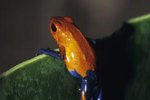
Amazon horned frogs (Ceratophrys cornuta) are notably robust and thickset amphibians whose homeland is South America, from French Guiana and Bolivia to Suriname and Brazil. These nocturnal and carnivorous frogs are impressively big, a result of not being at all choosy about what they eat.
Basic Information
Mature Amazon horned frogs usually grow to between 4 and 6 inches in length and a maximum of 1 pound. The males are usually smaller than the females, but more intensely colored. Females are generally beige, and the males can be anything from deep green to yellowish-green. They inhabit forests where they spend their time in heaps of foliage. Their reproduction takes place within pools. These frogs can breed starting at age 3 or 4.
Predators
Luckily for Amazon horned frogs, they have no confirmed "other animal" predators. Strangely, they are their own major predators. Amazon horned frog tadpoles frequently battle it out with each other immediately after birth. Adult specimens also routinely dine on tadpoles.
Their muted coloring operates as a handy disguise against predation, allowing these amphibians to stay inconspicuous and low-key in the face of potential danger. Would-be predators typically don't notice them. Their horns might further befuddle predators, as these protuberances could be confused for something else in the environment, such as stalks of foliage.
Pets
People sometimes keep these amphibians as pets, which occasionally could influence their numbers in the wild. Despite possible occasional trapping for sale as pets, the overall population of Amazon horned frogs in the wild is thought to be constant and in no current danger.
As Predators
Amazon horned frogs are ambush predators. They hide in piles of leaves, heads sticking out, to await small prey. Once they spot prey, they jump up and consume the unsuspecting animal intact and in one fell swoop. They secure their preys' bodies using their lengthy chompers. Amazon horned frogs' big mouths help them greatly in these efforts. Some typical food items for them are tiny frogs, fishes and mice.
References
- National Geographic: Amazon Horned Frog
- University of Michigan Animal Diversity Web: Ceratophrys Cornuta
- International Union for the Conservation of Nature Red List of Threatened Species: Ceratophrys Cornuta
- Brazil - Animal and Pantanal; David L. Pearson and Les Beletsky
- Bradt Travel Guide the Amazon; Roger Harris and Peter Hutchison
- Everything You Need to Know About Frogs and Other Slippery Creatures; Carrie Love, editor
Photo Credits
-
Jupiterimages/Comstock/Getty Images



